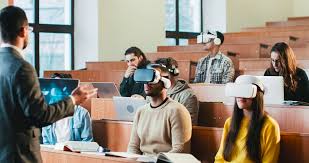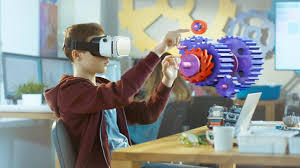
Virtual Reality (VR) is no longer just a tool for gaming and entertainment. By 2025, VR is rapidly transforming education, bringing immersive, interactive experiences into classrooms around the world. This technology is revolutionizing how students learn, engage, and retain information by making lessons more vivid, hands-on, and personalized.
Let’s explore how virtual reality is entering the classroom and reshaping education for the future.
1. Immersive Learning Experiences
VR enables students to step inside complex subjects:
- Exploring ancient civilizations or distant planets firsthand.
- Conducting virtual science experiments in safe, controlled environments.
- Visualizing abstract concepts like molecular structures or historical events.
This immersion makes learning memorable and engaging.
2. Enhancing Accessibility and Inclusion
VR breaks down barriers by:
- Providing tailored learning environments for students with disabilities.
- Offering language immersion and cultural experiences without travel.
- Enabling remote learning with a sense of presence and interaction.
It creates equitable educational opportunities worldwide.
3. Practical Training and Skill Development
Beyond traditional subjects, VR supports vocational training:
- Simulating medical procedures for healthcare students.
- Practicing technical skills like welding or machinery operation.
- Enhancing soft skills through role-playing scenarios in communication and leadership.
Students gain hands-on experience in a risk-free setting.
4. Teacher Empowerment and Curriculum Innovation
Teachers use VR to:
- Customize lessons based on student needs and interests.
- Incorporate gamification and interactive storytelling.
- Access analytics on student engagement and progress.
This fosters creativity and improves learning outcomes.
5. Challenges to Overcome
While promising, VR in education faces hurdles:
- High costs of equipment and content development.
- Ensuring age-appropriate and pedagogically sound material.
- Training teachers to effectively integrate VR.
- Addressing health concerns like motion sickness.
Ongoing innovation and investment are crucial to broad adoption.
6. The Future Classroom
By 2025 and beyond, VR is expected to:
- Integrate with augmented reality (AR) and mixed reality for blended experiences.
- Support collaborative virtual classrooms connecting students globally.
- Incorporate AI to personalize learning journeys further.
- Drive lifelong learning beyond formal education.
VR is set to become a staple in modern education.
Final Thoughts
Virtual reality is entering classrooms as a powerful tool to engage, inspire, and educate students in new ways. While challenges remain, its ability to make learning immersive, accessible, and practical heralds a bright future for education.
By embracing VR, educators can unlock students’ potential and prepare them for a rapidly changing world.
